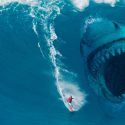Have you ever wondered what dinosaurs were afraid of? What creature, in the Cretaceous period, made taking a drink of water a dangerous gamble? I’m talking about terror crocs. No, no, not those crocs. Deinosuchus, otherwise, known as The Terror Crocodile. What made terror crocs such extreme predators? If they were still around, what would threaten their survival today? Were they able to eat dinosaurs, bones and all?
About 80 to 73 million years ago, Deinosuchus ruled over marshes and swamps, and feasted on unsuspecting dinosaurs. Fossils have been found showing that terror crocs grew up to 10 m (33 ft) long. And they likely weighed close to 5 tons, just about the size of a city bus. It had banana-sized teeth with jaws powerful enough to crush bones.
Many terror croc fossils have damaged teeth, leading paleontologists to believe that the terror crocs chomped on dinosaur bones. But scientists aren’t exactly sure if terror crocs were hunters or scavengers. So, if they happened to roam around today, would they hunt us?
This might surprise you, but crocodile attacks are actually more common than shark attacks. And they happen around the world. For many people, the risk of being attacked by a crocodile is a daily concern.
In fact, thousands of years of crocodile attacks have contributed to our evolutionary fear of reptiles, known as herpetophobia. Like our fear of spiders, we’ve developed this phobia over time. It’s a natural way that we protect ourselves. Like modern crocodiles, the deinosuchus was more of an opportunistic predator. If anything happened to come into its territory, these giant crocs would gobble it up, no questions asked.
Most crocodiles eat, on average, 50 full meals a year. As ectotherms, they gather heat from their environment. So they don’t need to eat as much as some animals to stay warm. In fact, the Nile crocodile can eat up to half its body weight in one meal. If the terror croc ate this much, it could eat about 2,000 kg (around 5,000 lbs) in a day. That’s about 36 average-sized humans for breakfast.
Crocodiles have a unique valve in their heart. It increases blood flow to their stomachs through a special aorta. This allows them to secrete gastric acid ten times faster than most animals. This means they can dissolve entire animals, bones and all.
As terrifying as it would be to see one of these giants walking down the street, it’s more likely that they would stick to their natural habitat of marshes, rivers, and swamps. So, you would need to be a extra careful about where you fish. Even though terror crocs could wreak havoc on our marshland habitats, we’d still hunt them for their skins, and make luxury leather accessories like handbags, shoes, and belts. Many crocodiles are also killed for their meat in Africa and parts of Asia.
Unfortunately, the bigger an animal is, the more attractive it is to trophy hunters. But with conservation efforts around the world, many endangered species of crocodile have managed to survive. With that said, if you think that terror crocs are scary, how would our lives change if the megalodon still roamed our oceans?
Sources
- “Crikey! How Crocs Digest Animals Whole“. Moskowitz, Clara. 2008. Livescience.Com.
- “What Scared Dinosaurs? The Terror Croc“. @laelaps, Follow. 2012.Smithsonian Magazine.
- “Cretaceous ‘Terror Crocodile’ Crushed Dinosaurs With Banana-Size Teeth“.Writer, Mindy. 2020. Livescience.Com.
- “Crocodiles: Facts & Pictures“.Contributor, Alina. 2014. Livescience.Com.
- “New Study Confirms The Power Of Deinosuchus And Its ‘Teeth The Size Of Bananas’ – Taylor & Francis Newsroom”. 2020. Taylor & Francis Newsroom.
- “Supersize Crocs | Crocodile Secrets Of Survival | Nature | PBS“. 2011. Nature.



























